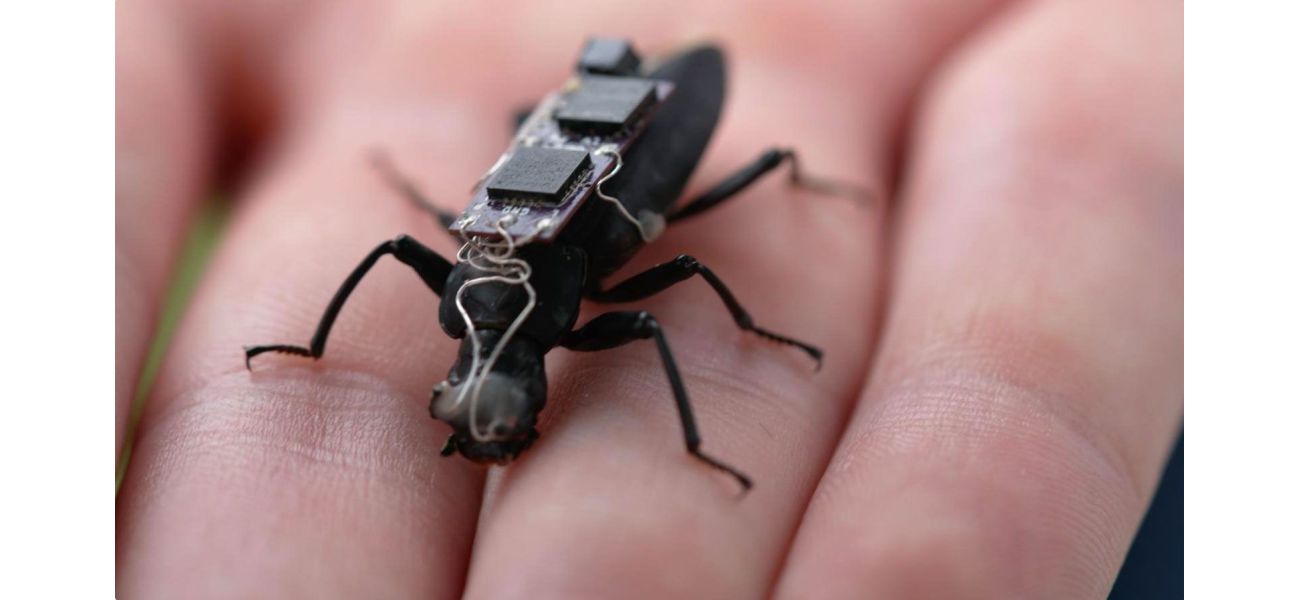In the future, large mechanical cockroaches may be used for search and rescue missions.
Lachlan Fitzgerald from the University of Queensland wants to build an army of insect-machines.
December 5th 2024.

As the patient lay submerged in the ice bath, the cold water numbed its body, acting as an anesthetic for the upcoming surgery. Lachlan Fitzgerald, a University of Queensland student, stood by, ready to begin the procedure. He carefully attached a tiny circuit board to the patient's back, creating a biohybrid robot that was part-living, part-machine.
But this patient was not your usual one. It was a beetle, and the circuit board acted like a backpack, sending electrical pulses to its antennae. This allowed Fitzgerald to control its movements, tapping into its natural agility. With this technology, he hoped to create a team of insect-machine search and rescue workers.
In an interview, Fitzgerald explained, "We see a future where after an urban disaster, like an earthquake or a bombing, where humans can't safely access the disaster site, being able to send in a bunch of cyborg beetles to navigate the disaster zone quickly and efficiently." Being able to control these insects remotely could potentially save many lives.
The biorobotics lab where Fitzgerald worked was also experimenting with other species, such as giant burrowing cockroaches and darkling beetles. These insects, found in various environments around the world, could prove to be valuable assets in disaster situations.
Despite the unconventional nature of his work, Fitzgerald was not grossed out by handling the bugs. In fact, he saw the potential for these cyborg insects to outperform traditional robots. "Insects are so adaptable compared to an artificial robotic system," he explained. "They can deal with different scenarios without needing complex computations like robots do."
However, before these cyborg insects could be put to use, the researchers had to perfect their ability to control their movements. This could take some time, but Fitzgerald was confident that in a few decades, these biohybrid robots could be saving lives.
And he wasn't the only one working on such projects. In other parts of the world, researchers were also creating robots from living organisms. For example, a team in California was implanting electronic pacemakers into jellyfish to control their swimming speed. And at Cornell University, robots controlled by a king oyster mushroom were being developed to sense and respond to their environment.
While the rise of these biohybrid robots had sparked ethical concerns, Fitzgerald and his colleagues assured that their work was being closely monitored and regulated. They had consulted with bioethicists to ensure that their interventions did not cause any stress or harm to the creatures.
Fitzgerald also addressed concerns about the welfare of the insects, stating that those who had been fitted with backpacks had normal life expectancies. "So I don't think they mind, per se," he said. However, he acknowledged that the question of whether these insects were conscious beings or not was still up for debate.
In the end, Fitzgerald believed that the potential of this technology to save lives outweighed any hesitancy towards it. "I think the benefits of this technology in disaster situations are significant," he stated. "And with the right regulations and oversight, we can ensure the well-being of these creatures while also utilizing their abilities."
But this patient was not your usual one. It was a beetle, and the circuit board acted like a backpack, sending electrical pulses to its antennae. This allowed Fitzgerald to control its movements, tapping into its natural agility. With this technology, he hoped to create a team of insect-machine search and rescue workers.
In an interview, Fitzgerald explained, "We see a future where after an urban disaster, like an earthquake or a bombing, where humans can't safely access the disaster site, being able to send in a bunch of cyborg beetles to navigate the disaster zone quickly and efficiently." Being able to control these insects remotely could potentially save many lives.
The biorobotics lab where Fitzgerald worked was also experimenting with other species, such as giant burrowing cockroaches and darkling beetles. These insects, found in various environments around the world, could prove to be valuable assets in disaster situations.
Despite the unconventional nature of his work, Fitzgerald was not grossed out by handling the bugs. In fact, he saw the potential for these cyborg insects to outperform traditional robots. "Insects are so adaptable compared to an artificial robotic system," he explained. "They can deal with different scenarios without needing complex computations like robots do."
However, before these cyborg insects could be put to use, the researchers had to perfect their ability to control their movements. This could take some time, but Fitzgerald was confident that in a few decades, these biohybrid robots could be saving lives.
And he wasn't the only one working on such projects. In other parts of the world, researchers were also creating robots from living organisms. For example, a team in California was implanting electronic pacemakers into jellyfish to control their swimming speed. And at Cornell University, robots controlled by a king oyster mushroom were being developed to sense and respond to their environment.
While the rise of these biohybrid robots had sparked ethical concerns, Fitzgerald and his colleagues assured that their work was being closely monitored and regulated. They had consulted with bioethicists to ensure that their interventions did not cause any stress or harm to the creatures.
Fitzgerald also addressed concerns about the welfare of the insects, stating that those who had been fitted with backpacks had normal life expectancies. "So I don't think they mind, per se," he said. However, he acknowledged that the question of whether these insects were conscious beings or not was still up for debate.
In the end, Fitzgerald believed that the potential of this technology to save lives outweighed any hesitancy towards it. "I think the benefits of this technology in disaster situations are significant," he stated. "And with the right regulations and oversight, we can ensure the well-being of these creatures while also utilizing their abilities."
[This article has been trending online recently and has been generated with AI. Your feed is customized.]
[Generative AI is experimental.]
0
0
Submit Comment





